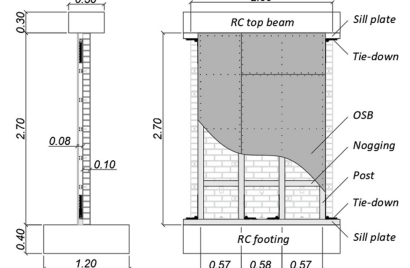Christian Salvatori, Gabriele Guerrini, Alessandro Galasco, and Andrea Penna
i Post-doctoral Research, Department of Civil Engineering and Architecture, University of Pavia, Pavia, Italy, christian.salvatori@unipv.it
ii Assistant Professor, Department of Civil Engineering and Architecture, University of Pavia, Pavia, Italy, Gabriele.guerrini@unipv.it
iii Research Consultant, Department of Civil Engineering and Architecture, University of Pavia, Pavia, Italy, alessandro.galasco@unipv.it
iv Full Professor, Department of Civil Engineering and Architecture, University of Pavia, Pavia, Italy, andrea.penna@unipv.it
ABSTRACT
The seismic vulnerability of unreinforced masonry (URM) structures and their extensive presence worldwide has driven significant efforts in the assessment and retrofit of existing buildings and in the design and detailing of new construction. The seismic performance of existing URM buildings is often compromised by local overturning mechanisms, as these constructions were predominantly conceived without consideration of horizontal forces. However, even if local failure is prevented through structural interventions or adequate construction details, the building might still result inadequate to withstand the in-plane seismic demand. To improve the performance of URM structures, retrofitted solutions involving material with significant tensile strength, such as Fabric-Reinforced Cementitious Matrices (FRCM), Composite-Reinforced Mortars (CRM), Near-Surface-Mounted (NSM) bars, steel or timber exoskeletons, applied to one or both sides of the masonry walls, are commonly employed. This paper presents a novel three-dimensional equivalent-frame macroelement that extends a previous two-dimensional formulation and resorts to a computationally efficient axial-flexural integration to simulate the nonlinear static and dynamic behavior of URM panels with a limited number of degrees of freedom. In particular, the versatility of the proposed formulation allows incorporating additional lumped and distributed reinforcement into the macro-element, and explicitly modeling several reinforcing and strengthening layouts. The capability of the resulting macroelement formulation in reproducing lateral strength and stiffness, hysteretic cycles, and displacement capacity of masonry panels, is finally validated against experimental outcomes.
KEYWORDS: Equivalent-frame modeling, masonry structures, nonlinear three-dimensional macroelement, seismic analysis, strengthening interventions.
079-Salvatori.pdf



